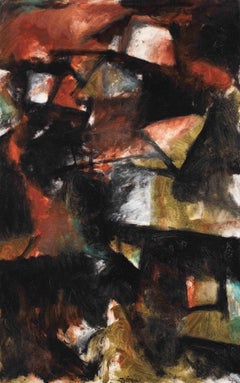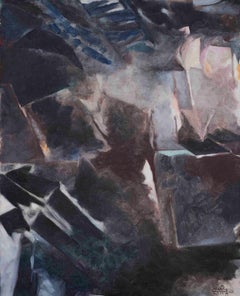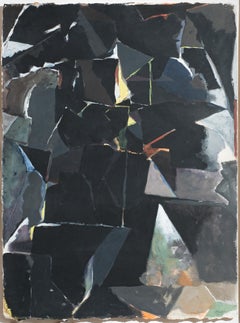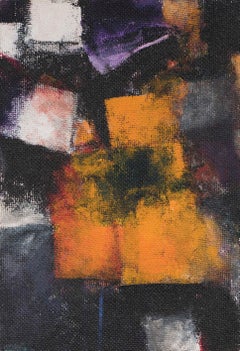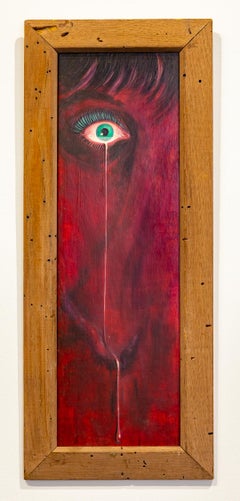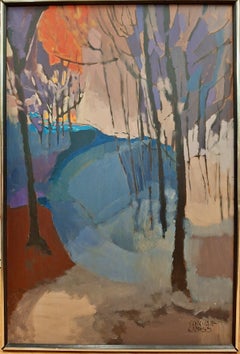Avigdor Arikha Paintings
to
1
1
1
2
Overall Width
to
Overall Height
to
5
5
5
4
3
3
1
14
781
719
706
691
5
Artist: Avigdor Arikha
Sombre
By Avigdor Arikha
Located in London, GB
oil on canvas
Category
20th Century Avigdor Arikha Paintings
Materials
Canvas, Oil
$37,593
Untitled, 1965
By Avigdor Arikha
Located in London, GB
oil on canvas
Category
20th Century Avigdor Arikha Paintings
Materials
Canvas, Oil
$53,704
Jet
By Avigdor Arikha
Located in London, GB
oil on canvas
Category
20th Century Avigdor Arikha Paintings
Materials
Canvas, Oil
$10,069
Abstract composition in black
By Avigdor Arikha
Located in London, GB
Gouache on paper
Category
20th Century Avigdor Arikha Paintings
Materials
Gouache
Composition in orange and black
By Avigdor Arikha
Located in London, GB
signed and dated (lower left)
Category
20th Century Avigdor Arikha Paintings
Materials
Masonite, Oil
Related Items
"Don't Cry Long" Abstracted and Distorted Self-Portrait, One Crying Eye
Located in Detroit, MI
"Don't Cry Long" is a self-portrait of the artist and an unusual one at that in which the artist portrays herself shedding tears. Perhaps it is an expression of some grief experienced by Ms. Woodlock, but it also admonishes her to not "Cry Long" while at the same time poking fun because of her elongated face and the one lone "long" tear tracing a pattern down her face. In addition to self-portraits, Ethelyn painted commissioned portraits. In this painting her head is cocked and her famous bangs hang down her forehead. Compare two self-portraits, “Up From Under”, and “M’Eyes" to "Don't Cry Long." The major differences are the close facial view and the brilliant blood red paint that fills the entire canvas.
This painting is included in the book, "Dreams Have Wings: An Artist's Journey into Magic and Mystery" printed in the United States, 1985. She describes "Don't Cry Long" as showing how funny looking we are, if we cry too long.
Ethelyn Woodlock...
Category
Mid-20th Century American Modern Avigdor Arikha Paintings
Materials
Oil, Masonite
A Summer's Sunset
Located in San Francisco, CA
In this abstract landscape, artist Geneva Cross conveys the mood of a dreamlike summer evening that might be remembered by any of us in its universality. Blending the basic elements ...
Category
1970s Abstract Avigdor Arikha Paintings
Materials
Masonite, Oil
Musicians
By Gen Paul
Located in New York, NY
Gen Paul (1895-1955 Fr.) lived in Montmartre, Paris France. He is know for his action painting with quick brush strokes and this work of art was painted around 1955-1960.
He was a mu...
Category
1950s Abstract Expressionist Avigdor Arikha Paintings
Materials
Gouache
An Abstract Geometric "Men of Matthew"
Located in San Francisco, CA
It’s time to bury the so-last-century idea that folks are either "right-brained,” i.e., naturally creative, or (boringly) "left-brained," always operating logically. And here’s just ...
Category
1950s Abstract Geometric Avigdor Arikha Paintings
Materials
Masonite, Oil
Antique American New England Fall Impressionist Framed Signed Oil Painting
Located in Buffalo, NY
Impressive early American impressionist landscape painting by Will S. Taylor (Born 1882). Oil on board. Framed. Signed. Image size, 12 by 13 inches.
Category
1970s Modern Avigdor Arikha Paintings
Materials
Oil, Masonite
$1,275
H 16 in W 18 in D 2 in
'Abstract Landscape', by Katherine Westphal, Oil on Board
Located in Oklahoma City, OK
Katherine Westphal's oil on board painting titled 'Abstract Landscape' embodies the stylistic qualities of abstract painting. Using a diverse color palette of orange, red, yellow, bl...
Category
Mid-20th Century Abstract Avigdor Arikha Paintings
Materials
Masonite, Oil
$1,840 Sale Price
20% Off
H 24.25 in W 30.25 in D 0.875 in
Landscape 130 by Jean Krille - Oil on canvas 50x35 cm
By Jean Krille
Located in Geneva, CH
Jean Krillé’s paintings are known for their expressive use of color and dynamic, abstract forms, blending realism with abstraction in his depictions of nature. His landscapes often f...
Category
Late 20th Century Neo-Expressionist Avigdor Arikha Paintings
Materials
Masonite, Oil
$1,230
H 19.69 in W 13.78 in D 0.79 in
Original 70's Hand Painted Textile Design Gouache botanical Style on White Paper
Located in ALCOY/ALCOI, ES
Abstract Expressionist design. Sealed on the back with the design studio name and number . Ilegible signature
We offer a small number of these original illustration designs by this ...
Category
1970s Abstract Avigdor Arikha Paintings
Materials
Paper, Gouache
$1,005
H 20.08 in W 34.65 in D 0.12 in
Landscape 124 by Jean Krille - Oil on masonite 70x50 cm
By Jean Krille
Located in Geneva, CH
Jean Krillé’s paintings are known for their expressive use of color and dynamic, abstract forms, blending realism with abstraction in his depictions of nature. His landscapes often f...
Category
Late 20th Century Neo-Expressionist Avigdor Arikha Paintings
Materials
Masonite, Oil
$1,900
H 27.56 in W 19.69 in D 0.4 in
Abstract Seated Figure
By Norbert Lenz
Located in Indianapolis, IN
Lenz was born in Norwalk, OH on March 2, 1900. A twentieth century American painter, illustrator and commercial artist, Lenz received his artistic education at the Huntington Polyte...
Category
20th Century Abstract Expressionist Avigdor Arikha Paintings
Materials
Masonite, Oil
Original 70's Hand Painted Textile Design Gouache abstract morden on White Paper
Located in ALCOY/ALCOI, ES
Abstract Expressionist design. Sealed on the back with the design studio name and number . Ilegible signature
We offer a small number of these original illustration designs by this ...
Category
1970s Abstract Avigdor Arikha Paintings
Materials
Paper, Gouache
$1,005
H 18.9 in W 34.65 in D 0.12 in
Oil on Canvas “BS Trust”
By Frank Arnold
Located in Fresno, CA
“BS Trust” is 36” x 36”. Frank Arnold’s paintings exhibit the highest quality materials for a truly archival piece, created to last generations. Much of Frank Arnold’s work is sourc...
Category
2010s Abstract Avigdor Arikha Paintings
Materials
Canvas, Oil
Avigdor Arikha paintings for sale on 1stDibs.
Find a wide variety of authentic Avigdor Arikha paintings available for sale on 1stDibs. You can also browse by medium to find art by Avigdor Arikha in paint, oil paint, canvas and more. Not every interior allows for large Avigdor Arikha paintings, so small editions measuring 10 inches across are available. Customers who are interested in this artist might also find the work of Roni Taharlev, Shay Kun, and David Leviathan. Avigdor Arikha paintings prices can differ depending upon medium, time period and other attributes. On 1stDibs, the price for these items starts at $9,291 and tops out at $51,144, while the average work can sell for $12,388.
